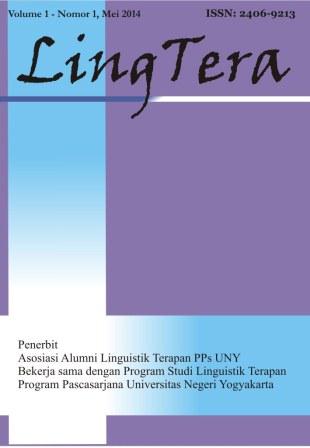Non-EFL students' perspectives on English learning in higher education institution: The case of Indonesian non-English major
DOI:
https://doi.org/10.21831/lt.v10i1.57996Keywords:
EFL, language learning, perspective, motivationAbstract
References
Ahmadi, M. R. (2017). The impact of motivation on reading comprehension. International Journal of Research in English Education, 2(1), 1-7.
Al-Ta'ani, M. H. (2018). Integrative and instrumental motivations for learning English as a university requirement among undergraduate students at Al-Jazeera University/Dubai. International Journal of Learning and Development, 8(4), 89. https://doi.org/10.5296/ijld.v8i4.13940
Ametova, O. (2020). The influence of integrative motivation and instrumental motivation on learning English as a foreign language. Journal of Critical Reviews. 942-945.
Bakar R. (2014). The effect of learning motivation on student's productive competencies in vocational high school, West Sumatra. International Journal of Asian Social Science. 4(6), 722-732.
Creswell, J. W. (2014). A concise introduction to mixed methods research. SAGE publications.
Dí¶rnyei, Z. (1998). Motivation in second and foreign language learning. Language teaching, 31(3), 117-135.
Dutta, S. (2019). The importance of "English" language in today's world. International Journal of English Learning &Teaching Skills, 2(1), 1028–1035. https://doi.org/10.15864/ijelts.2119
Erickson F. (1986). Qualitative methods in research on teaching. In M. Wittrock (Ed.), Handbook of research on teaching (3rd ed., pp. 119–61). Macmillan.
Fairclough, N. (1993). Critical discourse analysis and the marketization of public discourse: The universities. Discourse & society, 4(2), 133-168.
Fischer, C., Malycha, C. P., & Schafmann, E. (2019). The influence of intrinsic motivation and synergistic extrinsic motivators on creativity and innovation. Frontiers in Psychology, https://doi.org/10.3389/fpsyg.2019.00137
Gardner, R. C. (2001). Integrative motivation and second language acquisition. Motivation and second language acquisition, 23(1), 1-19.
Gardner, R. C., & Lambert, W. E. (1972). Attitudes and Motivation in Second Language Learning. Newbury House Publishers
Gardner, R. C., Lalonde, R. N., & Pierson, R. (1983). The socio-educational model of second language acquisition: An investigation using LISREL causal modeling. Journal of language and social psychology, 2(1), 1-15. https://doi.org/10.1177/0261927X8300200101
Grassini, S., & Laumann, K. (2020). Questionnaire measures and physiological correlates of presence: A systematic review. Frontiers in Psychology, 11. https://doi:10.3389/fpsyg.2020.00349
Hein, D., Mai, C., and HuíŸmann, H. (2018). "The usage of presence measurements in research: A review," In Proceedings of the International Society for Presence Research Annual Conference (Presence) (Prague: The International Society for Presence Research).
Henry, A., Davydenko, S., & Dí¶rnyei, Z. (2015). The anatomy of directed motivational currents: Exploring intense and enduring periods of L2 motivation. The Modern Language Journal, 99(2), 329-345.
Jindapitak, N. (2019). English as an ASEAN lingua franca and the role of nativeness in English education in Thailand: Moving toward the ASEAN Economic Community (AEC). English Today, 35(2), 36-41. https://dx.doi.org/10.1017/S026607841800024X
Luthans F. (2012) Organizational behavior (7th Ed.). McGraw-Hill, Inc.
Maloney, I. (2022). The impact of creative writing on L2 writer confidence. International Journal of TESOL Studies.
Molyaningrum, N., & Suyata, P. (2021). Pengaruh motivasi belajar, fasilitas belajar, dan penguasaan kosakata terhadap prestasi belajar bahasa Inggris siswa. LingTera, 8(1).
Moskovsky, C., Alrabai, F., Paolini, S., & Ratcheva, S. (2013). The effects of teachers' motivational strategies on learners' motivation: A controlled investigation of second language acquisition. Language learning, 63(1), 34-62.
PokrivÄáková, S. (2020). Introducing English To Very Young Learners I. Tomas Bata University Press.
Prihatin, Y. (2015). The removal of English language for elementary school in Curriculum 2013. Jurnal Dialektika Program Studi Pendidikan Bahasa Inggris, 3(1), 53-68.
Rahayu, R. S. (2018). Studi literatur: Peranan bahasa Inggris untuk tujuan bisnis dan pemasaran. Jurnal Pemasaran Kompetitif, 1(4), 149–158.
https://doi.org/10.32493/jpkpk.v1i4.1553
Rao, P. S. (2019). The importance of English in the modern era. Asian Journal of Multidimensional Research (AJMR), 8(1), 7.https://doi.org/10.5958/2278-4853.2019.00001.6
Rozmatovna, A. (2020). The influence of integrative motivation and instrumental motivation on learning English as a foreign language. Journal of Critical Reviews 7(12), 942-945.
Ryan, R. M., & Deci, E. L. (2000). Self-determination theory and the facilitation of intrinsic motivation, social development, and well-being. American Psychologist, 55(1) 68-78.
Sari, D. M., & Ashadi, A. (2020). Graduate students' attitudes & self-directed for lifelong learning in foreign language environment. LingTera, 7(1), 38-50.
Serin, H. (2018). The use of extrinsic and intrinsic motivations to enhance student achievement in educational settings. International Journal of Social Sciences & Educational Studies, 5(1), 191-194.
Subakthiasih, P., & Putri, I. G. (2020). An analysis of students' motivation in studying English during Covid-19 pandemic. Linguistic, English Education and Art (LEEA) Journal, 4(1), 126-141. https://doi.org/https://doi.org/10.31539/leea.v4i1.1728
Sujarweni, V. W., & Utami, L. R. (2019). The master book of SPSS. Anak Hebat Indonesia.
Sulaiman, Z. S. (2022). The perceptions of English teacher and parents on the removal of English subject in elementary school. Vision, 18(1), 1-15. http://dx.doi.org/10.30829/vis.v18i1.1396
Taherdoost, H. (2016). Validity and reliability of the research instrument; How to test the validation of a questionnaire/survey in research. International Journal of Academic Research in Management, 5(3), 28-36.
Tilavova, M. (2021). The impact of motivation in learning foreign languages. Журнал иноÑтранных Ñзыков и лингвиÑтики, 4(9).
Ulfa, M., & Bania, A. S. (2019). EFL student's motivation in learning English in Langsa, Aceh. Studies in English Language and Education, 6(1), 163–170.https://doi.org/10.24815/siele.v6i1.12860
Zein, S. (2020). Language Policy in Superdiverse Indonesia (1st ed.). Routledge. https://doi.org/10.4324/9780429019739
Downloads
Published
How to Cite
Issue
Section
Citation Check
License
LingTera allows readers to read, download, copy, distribute, print, search, or link to its articles' full texts and allows readers to use them for any other lawful purpose. The journal allows the author(s) to hold the copyright without restrictions. Finally, the journal allows the author(s) to retain publishing rights without restrictions.
- Authors are allowed to archive their submitted articles in an open-access repository.
- Authors are allowed to archive the final published article in an open-access repository with an acknowledgment of its initial publication in this journal.

Psychology, Evaluation, and Technology in Educational Research is licensed under a Creative Commons Attribution-ShareAlike 4.0 International License.
Based on a work at https://petier.org/index.php/PETIER.









